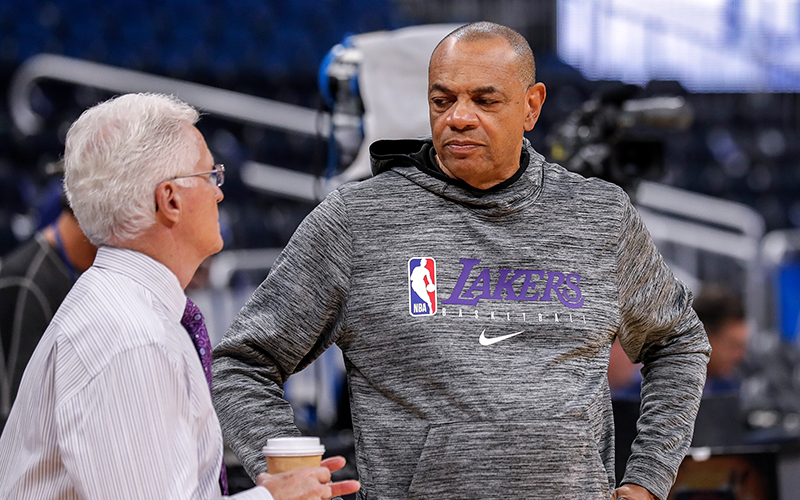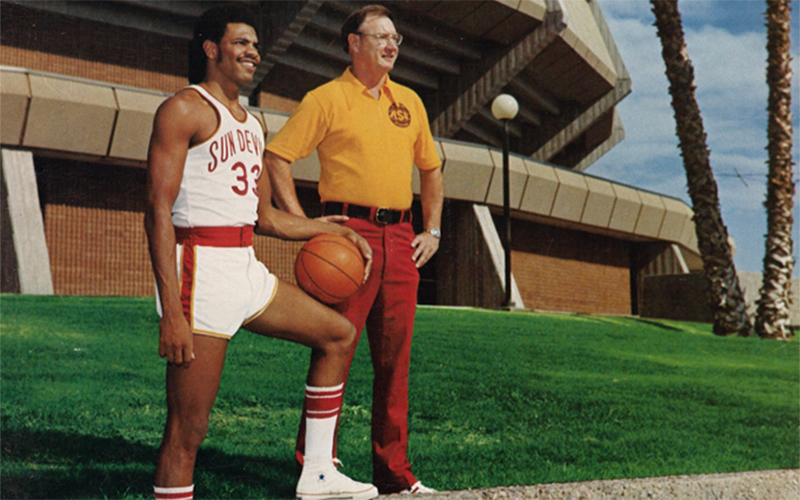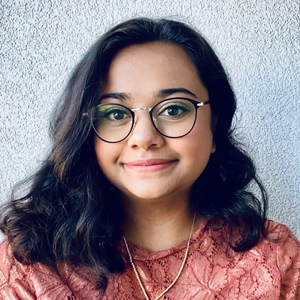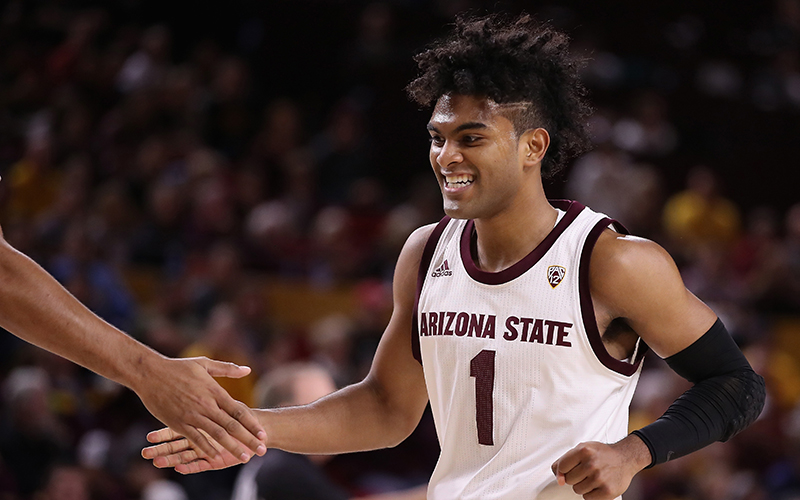
Lionel Hollins (right) has continued a successful run in basketball and enjoys his role as an assistant coach with the Los Angeles Lakers. He jumped into the national spotlight during his two seasons playing at Arizona State. (Photo by Don Juan Moore/Getty Images)
PHOENIX — As confetti sprinkled down on the court inside the NBA bubble in Orlando, Florida, most of the Los Angeles Lakers’ players and coaches celebrated their championship together, marking the end to an anomalous season. Assistant coach Lionel Hollins watched his team win on television from his home in Memphis.
The Arizona State basketball alum said a fellow assistant coach Facetimed him in the locker room bringing him into the team celebration. He watched champagne spray across the room from his phone as grown men rejoiced like children.
Not long after, his son dropped by gifting his now two-time NBA champ father a bottle of the traditional sport celebration bubbly beverage to commemorate the occasion.
“I open the champagne and spray it a little bit and take a swig, and that was the gist of the celebration,” Hollins said. “I actually have a replica of the NBA championship trophy from when I won as a player. I went and got that and took some pictures with it, and I was sending it out to everybody.”
That was enough excitement for him, he said.
Hollins experienced plenty of excitement during his successful playing career, too, and one of his biggest accomplishments at ASU was leading the Sun Devils to a memorable NCAA Tournament run in 1975. It was the last time ASU advanced to the Elite Eight, its season ending against UCLA, the team the Sun Devils face tonight at Desert Financial Arena.
It was the last game of his college career but the beginning of an NBA one as a player and coach that eventually landed him in Los Angeles.
Hollins joined the Lakers coaching staff in 2019 and sat on the sidelines for 63 games before the season shut down in March when COVID-19 cases began their first nationwide surge. When the NBA resumed play on ESPN’s Orlando campus in August, the league deemed Hollins as high risk.
So, the tenured coach worked remotely hundreds of miles away. When he was back in Los Angeles he got up at 5 a.m. to join the 8 a.m. East Coast team meeting. He said that became less of an issue when he relocated to Memphis for the remainder of the season.
He is, of course, back in Los Angeles, helping guide a Lakers team that is off to a 6-2 start.
Even at 67, Hollins said he wouldn’t want to do anything else. This is what he loves.
“I enjoy what I do. I enjoy working with the young people,” he said. “I feel like I have a lot to offer them outside of just basketball knowledge, but experience and having played and having lived.”
While the team played in the bubble he was unable to have regular conversations with players where he could chat with them at practice or as they practiced free throws. He is glad to be back in the gym, even if that means LeBron James cracks jokes every time he tries to join the guys on the court.
“They love to mess with me,” Hollins said. “They’ll probably look at me and my gray beard, probably like, ‘Dang! You didn’t have a gray beard when you left Coach, what happened?’”
Jack Schrader, Hollins’ teammate at ASU, said it doesn’t surprise him that his former teammate is still coaching. Hollins’ work ethic was a cut above even back when they played together, he said. Plus, the two of them aren’t that old, he said. They still have a lot of energy.

Lionel Hollins (left) and coach Ned Wulk led the Arizona State men’s basketball team to the Elite Eight in 1975. (Photo courtesy Sun Devil Athletics)
While Hollins’ coaching history in the NBA dates back decades, he also had a fruitful collegiate career playing for coach Ned Wulk for two seasons. Hollins’ jersey currently sways in the rafters of Desert Financial Arena above the Ned Wulk court.
Bruce Haroldson, ASU assistant coach under Wulk, said Hollins reignited the program. Haroldson recruited Hollins out of Dixie State University, at the time a junior college in St. George, Utah. He remembers Wulk joining him on the last recruiting trip which was rare for a head coach to do at the time.
“I don’t think I was ever happier than my whole life,” Haroldson said about Hollins signing the letter of intent. On their way back to Phoenix they stopped in Las Vegas. Haroldson said he remembers cruising around casinos looking “outrageously happy.”
With Hollins in the lineup, the Sun Devils racked up 43 wins in two seasons including that deep NCAA Tournament run in his last collegiate campaign.
In his two years, Hollins averaged 17 points and just over four assists per game. The Portland Trailblazers drafted him sixth in the 1975 NBA draft.
Haroldson said they were so successful because they bought into playing team basketball.
“They were all for each other, and they didn’t care who got the credit,” he said. “They all just played for each other.”
While Haroldson praises Hollins’ basketball acumen, he holds their relationship in higher esteem. In March when the NBA shut down and COVID-19 started to take its toll, Hollins called him and they talked for an hour and six minutes.
Haroldson distinctly remembers because he said he’s never talked to anyone on the phone that long.
“It doesn’t matter if we don’t talk for six to seven months or a year,” he said. “When we talk it’s just like we live next door to each other.”
Schrader had a similar relationship with him. Schrader said while he hasn’t seen Hollins in years they have a “consistent friendship.”
He was also drafted in the same class as Hollins but ended up taking his talents overseas to Spain. Currently he lives in a small town in Missouri teaching Spanish.
Schrader remembers a time he had a student disabled with cerebral palsy that was going to visit Phoenix. With a simple phone call, Hollins, who was a Suns assistant at the time, set up Schrader’s students with tickets to a game.
“We’re still teammates and if we can, we’ll help each other out even though we haven’t seen each other for years,” Schrader said.
Haroldson said Hollins’ humanitarian work stands out above the rest. Haroldson visited his former player when he coached the Memphis Grizzlies. Hollins didn’t bring him to the practice facility or down Beale Street first. He invited him to a children’s hospital where he frequented.
“Tells me a lot about him,” Haroldson said. “He wasn’t interested in showing me the sights and sounds of Memphis, so much as was what the humanitarianism that he has in his heart.”
Wulk also saw people first and the game second, Haroldson said. He’ll always remember a moment when a game came down to two free throws with no time remaining.
The player missed the first and then the second. Everyone was devastated, but Wulk rushed to the court and hugged his player. The story still brings Haroldson to tears. He said Hollins is the same way.
When Haroldson recruited Hollins, he was a top prospect in the country but chose ASU because of Wulk.
“He was like a father figure that most of the coaches that I had always been,” Hollins said. “He challenged me to be the best that I could, he didn’t let me slide one iota.”
Haroldson said he sees similarities between Wulk and current ASU coach Bobby Hurley.
“Ned really cared about his players a lot, and I see Hurley really cares about his players a lot,” Haroldson said.
Hurley’s done a great job with recruiting and building the program, Hollins said. The success his team brought in ‘75 led to high ranking recruits like Byron Scott and Fat Lever.
ASU recruited two top 30 players out of high school in Josh Christopher and Marcus Bagley, looking to create similar success Hollins and Schrader had.
As the maroon and gold hope to trend in a positive direction, so do the purple and gold of Hollins’ current team. He is excited about this season’s team.
“We have a game plan, we have a culture, we have players who have been through it,” he said.
After playing in the league, he worked as an assistant for the Phoenix Suns for seven years and the Vancouver turned Memphis Grizzlies for another 10 years before the organization hired Hollins as head coach in 2009.
Although he hadn’t been an assistant for 10 years, he said it’s a blessing to work under coach Frank Vogel because he’d been out of coaching for three years. He loves the closeness the coaching staff has, and that directly impacts the game.
“When there’s a gap in the chemistry between individuals on whatever level it is, it shows up eventually on the court,” he said.
Their chemistry bond prevailed through a pandemic, a four-month shutdown, a racial equality movement which spurred the league into action, and playing in a bubble leaving some behind.
After they won, Hollins joked that they’re going to run it back, but that raised the question: What would the team look like heading into a fresh season?
“All those future questions come up before you can even let the champagne sting get out of your eyes,” he said.
That’s basketball. And Hollins is thrilled to still be a part of it.

